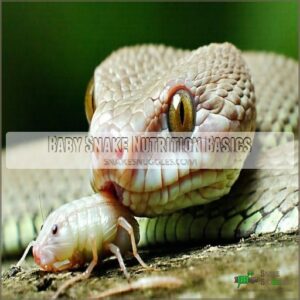This site is supported by our readers. We may earn a commission, at no cost to you, if you purchase through links.
 When hunting for the best food for baby snakes, you’ll want to match prey size precisely to your slithery friend’s body width.
When hunting for the best food for baby snakes, you’ll want to match prey size precisely to your slithery friend’s body width.
Most baby snakes thrive on protein-rich options like tiny mice (pinkies), insects, or species-specific prey like crickets or small lizards.
After exhausting their initial yolk sac nutrition, they’ll need frequent feedings—roughly every 3-7 days depending on their weight and species. Always choose live prey to stimulate natural hunting instincts, but make certain it’s small and safe.
Maintaining proper temperature (80-85°F) and humidity (50-70%) creates a perfect feeding environment.
Remember, each snake species has unique dietary needs.
Table Of Contents
- Key Takeaways
- Baby Snake Nutrition Basics
- Choosing The Right Food for Baby Snakes
- Setting Up a Stress-Free Feeding Environment
- Feeding Techniques for Baby Snakes
- Common Feeding Mistakes to Avoid
- How Often to Feed Baby Snakes
- Water and Hydration for Baby Snakes
- Baby Snake Growth and Development
- Potential Risks and Health Issues
- Transitioning to Adult Snake Diet
- Frequently Asked Questions (FAQs)
- How Can You Tell the Age of a Baby Snake?
- What Temperatures Do Baby Snakes Need to Thrive?
- How Do Wild Baby Snakes Find Food and Water on Their Own?
- What Health Problems Are Common in Baby Pet Snakes?
- How Big is a Newborn Snake Compared to Its Parents?
- What should I feed a baby snake?
- What is the best food for small snakes?
- What to feed garter snake babies?
- What do baby smooth snakes eat?
- Can baby snakes eat fish or reptiles?
- Conclusion
Key Takeaways
- You’ll want to match prey size precisely to your baby snake’s body width, selecting live prey like pinky mice, insects, or species-specific food to stimulate natural hunting instincts.
- Your baby snake’s diet requires careful monitoring, with feeding frequencies typically ranging from 5 to 7 days, and you’ll need to adjust based on the snake’s species, age, and individual growth rate.
- You’ll need to create a stress-free feeding environment with proper temperature (80-85°F) and humidity (50-70%), providing hiding spots and fresh water to support your snake’s health and development.
- You’ll have to be vigilant about potential feeding risks, including nutritional deficiencies, choking hazards, and species-specific dietary requirements, consulting a reptile veterinarian to ensure your snake’s optimal nutrition and growth.
Baby Snake Nutrition Basics
If you’re a new snake owner, understanding the nutritional needs of your baby snake is essential for its survival and growth.
Your slithery companion starts life with a remarkable ability to sustain itself through its yolk sac.
baby snake requires precise, carefully planned feeding strategies to thrive in captivity.
Newborn Snake Yolk Sac Nutrition
Every newborn snake’s yolk sac is a nutritional marvel.
These compact nutrient powerhouses sustain hatchlings for up to a month, eliminating the need for external feeding during their most vulnerable period.
The yolk sac’s nutrient composition and absorption rate are precisely calibrated to support critical developmental stages, ensuring the baby snake’s survival without immediate parental intervention.
Additionally, a well-planned protein-rich diet is essential for continued growth and development after the yolk sac is depleted.
Importance of Self-Sufficiency in Snakes
From the moment they’re born, baby snakes showcase an extraordinary evolutionary advantage of self-sufficiency.
Their innate survival skills kick in immediately, allowing them to navigate their environment without constant parental care.
This remarkable adaptation stems from their ability to rely on yolk sac nutrition, enabling independent hunting and rapid development right from birth.
Mother Snake Abandonment After Birth
A mother snake’s abandonment isn’t a sign of neglect, but a survival strategy deeply rooted in snake evolution.
This hands-off approach is nature’s brilliant adaptation for snake hatchlings.
- Newborn snakes emerge fully equipped with innate hunting skills
- Evolutionary advantages prioritize offspring independence
- Environmental factors shape parental care variations
- Hatchlings possess built-in nutritional reserves from yolk sacs
Nature’s design guarantees baby snakes thrive independently from birth.
Choosing The Right Food for Baby Snakes
Feeding your baby snake isn’t just about tossing in any prey that fits, but carefully selecting the right nutritional match for its species and size.
You’ll want to start with appropriately sized live prey like pinky mice, ensuring your slithery friend gets the precise nutrients needed for healthy growth and development.
Species-Specific Diet Considerations
Most snake species have wildly different dietary needs that can make or break your tiny slithery companion’s health. Understanding these nuanced prey type variations is essential for preventing nutritional deficiencies and supporting best growth rates.
| Snake Species | Initial Prey | Feeding Schedule |
|---|---|---|
| Hognose | Insects | Every 5-7 days |
| Children’s Python | Larvae | Weekly |
| Anaconda | Small rodents | Bi-weekly |
Mastering species-specific diets guarantees your baby snake thrives from day one.
Prey Size and Frequency Guidelines
When sizing prey for baby snakes, think of a ruler sizing up a perfect fit. Your snake’s prey should never exceed its widest body point—a critical rule in snake feeding schedules.
Different species require unique prey size charts, so monitor your snake’s growth carefully.
Proper feeding prevents potential hazards and supports healthy development in baby snake diets.
Importance of Live Prey for Baby Snakes
Giving live prey to your baby snake transforms its feeding experience, triggering critical survival instincts. Baby snakes thrive on movement-based hunting strategies that mimic their natural environment.
- Stimulates predatory behavior and hunting skills
- Provides mental and physical enrichment
- Mimics natural diet and ecosystem interactions
- Encourages muscle development and coordination
- Reduces stress through instinctual feeding patterns
Live prey isn’t just food—it’s a survival masterclass for your slithery companion.
Setting Up a Stress-Free Feeding Environment
Creating a calm, secure environment is essential for your baby snake’s successful feeding and overall health.
You’ll want to focus on temperature control, humidity management, and providing safe hiding spots that mimic their natural habitat.
Providing a Comfortable and Secure Enclosure
Every new baby snake deserves a sanctuary that feels like home. Your enclosure isn’t just a space – it’s a lifeline for your slithery friend’s comfort and nutrition. A stress-free feeding environment also involves respecting your snake’s feeding frequency, ensuring their overall well-being.
| Feature | Recommendation |
|---|---|
| Substrate | Smooth, absorbent material |
| Hide Box | Multiple secure options |
| Enclosure Size | Species-specific dimensions |
| Ventilation | Adequate air circulation |
| Surface | Textured, easy to clean |
Creating a stress-free zone means thinking like a baby snake – safety first!
Maintaining Proper Temperature and Humidity
Dial in your baby snake’s temperature and humidity like a pro.
Precise environmental control matters big time for these delicate reptiles.
Set up temperature gradients ranging from 80-85°F on the warm side and 75-80°F on the cool side. Ideal humidity levels hover between 50-70%, depending on your snake’s species.
Invest in reliable monitoring equipment to keep your slithery friend thriving.
Importance of Hiding Spots for Baby Snakes
Just as maintaining temperature supports your baby snake’s comfort, providing hiding spots creates a sanctuary that shields them from stress. Imagine a mini snake fortress that meets multiple survival needs.
You can find suitable hiding spots like [baby snake hides/dp](.com baby snake hides.com baby+snake.com baby snake’s goddess baby snakes for baby snake for baby snake was baby-snassistant.com baby snake snakes do baby baby snake that baby snake snakes do baby snake snakes, baby snake snakes
baby snakes snakes
baby snake snakesanny baby snakes. You can find suitable hiding spots like baby snake hides that meets multiple survival needs:
- Reduces anxiety and cortisol levels
- Mimics natural habitat conditions
- Supports exploration and hunting instincts
- Prevents predator-like sensations
- Boosts overall feeding and nutrition success
Hiding spots aren’t just shelter—they’re your baby snake’s psychological lifeline.
Feeding Techniques for Baby Snakes
Feeding your baby snake requires careful techniques that’ll set the stage for its healthy growth and development.
You’ll want to master the art of prey selection, scent management, and feeding strategies.
to guarantee your slithery friend thrives from its very first meal.
Live Pinky Mouse as Initial Prey
Once you’ve set up a cozy snake habitat, it’s time to tackle first feedings.
Live pinky mice reign supreme as the go-to meal for baby snakes, offering a protein-packed punch that triggers natural hunting instincts.
Selecting the right size matters – too big risks injury, too small won’t satisfy.
Using frozen prey as an alternative reduces parasite risk.
| Pinky Mouse Size | Feeding Recommendation |
|---|---|
| Tiny (Newborn) | Smallest available |
| Small (1 week) | Match snake’s width |
| Medium (2 weeks) | Slight challenge |
Scent Removal and Transfer Methods
Prey washing techniques are a game-changer when feeding baby snakes, transforming their mealtime from meh to marvelous. Mastering scent removal can trigger those primal hunting instincts and make feeding time smoother.
Providing the right baby snake food options can be essential in a snake’s diet.
- Wash pinky mice thoroughly to remove strong odors
- Gently rub prey with a lizard to stimulate hunting response
- Use careful odor transfer methods to attract your snake’s attention
Scent masking is your secret weapon in snake feeding success.
Offering Alternative Prey for Picky Eaters
Hit a roadblock with baby snake feeding? Switch up the menu to stimulate those picky eaters! Different prey can spark their hunting instincts and keep nutrition on track.
| Prey Type | Size Recommendation | Hunting Stimulation |
|---|---|---|
| Crickets | Tiny | High |
| Lizard Scents | Varies | Moderate |
| Small Frogs | Appropriate Size | High |
| Wax Worms | Tiny | Low |
| Scented Mice | Perfect Match | Very High |
Consult a reptile vet to guarantee safe, species-specific alternatives that won’t compromise your baby snake’s health.
Common Feeding Mistakes to Avoid
Regarding feeding your baby snake, you’ll want to steer clear of common pitfalls that can compromise its health and development.
Avoiding force-feeding is critical to ensuring your slithery friend grows up healthy and strong.
Maintaining proper prey size is also important.
Understanding species-specific nutritional needs is critical for healthy growth.
Force Feeding Risks and Consequences
Force feeding introduces a dangerous gauntlet of risks for baby snakes, potentially triggering severe internal injuries and aspiration complications.
You’ll want to avoid this drastic intervention at all costs.
Stress responses can devastate a newborn snake’s delicate digestive system, increasing mortality risk dramatically.
Professional veterinarians unanimously warn that force feeding causes more harm than good in fragile baby snake nutrition.
Overfeeding and Underfeeding Baby Snakes
Though baby snakes have impressive appetites, finding the right balance in feeding is essential for their health. Overfeeding or underfeeding can derail their growth trajectory and impact long-term development.
- Stunted growth lurks behind every misplaced meal
- Weight checks become your snake’s lifeline
- Feeding schedules protect against nutritional nightmares
Mastering ideal feeding requires keen observation and precise portion control, ensuring your slithery friend thrives without unnecessary risks.
Feeding Baby Snakes Incorrect Prey
With baby snake prey, one wrong move can spell disaster.
Feeding incorrect food types triggers serious digestive issues and long-term health complications.
Different baby snake species have unique dietary needs—what works for a hognose might poison a python. Always research your specific snake’s best diet, considering prey size, toxicity concerns, and nutritional requirements to guarantee your slithery friend stays healthy. Different baby snake species have unique dietary needs. Always research your specific snake’s best diet.
How Often to Feed Baby Snakes
Understanding the right feeding frequency for your baby snake is essential to its health and growth.
You’ll want to tailor your feeding schedule to your snake’s specific species, age, and individual needs.
typically offering appropriately sized prey every 5-7 days during the early stages of development.
Feeding Frequency Based on Species and Age
After dodging the pitfalls of feeding mistakes, you’ll want to nail down your baby snake’s feeding frequency like a pro.
Species variations and age factors play huge roles in crafting the perfect snake meal plan:
- Small snakes need more frequent meals (every 5-7 days)
- Large snake species can space out feedings
- Monitor growth rates to adjust feeding schedules
Hungry hatchlings have big appetites that change as they slither into adulthood.
Monitoring Baby Snake Health and Growth
Tracking your baby snake’s growth rate is like being a detective of scales and slithers.
Watch for regular shedding, steady weight gain, and consistent appetite.
Note defecation patterns as key health indicators. Weigh your snake weekly, comparing against species-specific growth charts.
Any sudden changes in baby snake nutrition or behavior? That’s your cue to consult a reptile veterinarian pronto.
Adjusting Feeding Frequency as Needed
Snake growth isn’t a one-size-fits-all journey.
Your baby snake’s feeding frequency depends on individual needs, including growth spurts, weight changes, and seasonal shifts.
Monitor their health closely, adjusting the snake feeding schedule as they develop. Some baby snakes might need more frequent meals during rapid growth periods, while others require less frequent feeding. Stay flexible and observant.
Water and Hydration for Baby Snakes
You’ll need to provide consistent hydration for your baby snake, as water is essential for its survival and health.
Keep a small, clean water dish in the enclosure and monitor it regularly.
To make sure your slithery friend stays well-hydrated and thrives.
Importance of Access to Fresh Water
Fresh water isn’t just a luxury for your baby snake—it’s a lifeline. Dehydration can quickly turn deadly, making clean water sources absolutely necessary.
Your slithery friend needs constant access to a shallow, stable water bowl that won’t tip over.
Keep it pristine, replacing the water daily to prevent bacterial growth and guarantee your newborn snake stays hydrated and healthy.
Additionally, providing prey items with proper hydration through food can also aid in keeping your baby snake well-hydrated.
Obtaining Water From Food and Environment
Your slithery sidekick’s water world isn’t just about a bowl—it’s a multi-source survival strategy.
Baby snakes cleverly obtain hydration through food moisture, environmental humidity, and occasional soaking.
Their prey’s water content often meets important hydration needs, while ambient conditions play a key role in maintaining their delicate water balance during early life stages.
Preventing Dehydration in Baby Snakes
In the delicate world of baby snake hydration, staying ahead of dehydration is like threading a needle. Here’s your survival guide:
- Monitor humidity levels between 50-70% using a reliable hygrometer
- Mist enclosures gently to provide supplemental water sources
- Recognize early dehydration signs like wrinkled skin and sunken eyes
- Use shallow water dishes that allow safe, easy drinking for newborn snake feeding
Baby Snake Growth and Development
You’ll be amazed at how quickly your baby snake grows and develops with the right nutrition and care.
Understanding the fundamentals of snake growth will help you provide the best environment and diet to support your slithery friend’s rapid maturation and health.
Rapid Growth and Maturation Rates
From the moment they hatch, baby snakes rocket through incredible growth spurts that’ll make your head spin.
These tiny predators mature at lightning speed, reaching sexual maturity in just two to three years.
Different species zoom through their growth stages at varying rates, with some baby snakes developing muscle and hunting skills faster than you’d ever imagine.
Importance of Proper Nutrition for Growth
Snakes grow like rockets, and their diet fuels this lightning-fast development. Proper nutrition acts as the high-octane fuel for baby snake growth stages, powering metabolism and preventing long-term health issues.
- Nutritional deficiencies stunt physical progress
- Protein-rich diets accelerate cellular development
- Balanced meals support immune system strength
- Consistent feeding triggers peak metabolic functions
Small meals, big impact – that’s the secret to nurturing a thriving baby snake.
Monitoring Baby Snake Health and Development
Keep a watchful eye on your baby snake’s development to make sure it’s thriving. Tracking growth isn’t just about size—it’s about understanding your slithery friend’s overall health.
Here’s a quick reference guide to monitoring your baby snake’s progress:
| Indicator | What to Look For | Normal Range | Action Needed |
|---|---|---|---|
| Growth Rate | Steady increase in length | 10-15% monthly | No intervention |
| Shedding | Clear, complete skin shed | Every 2-4 weeks | Check humidity |
| Weight | Consistent weight gain | 5-10% weekly | Consult veterinarian |
| Behavior | Active, alert, regular feeding | Consistent appetite | Monitor closely |
Each milestone tells a story of your snake’s health journey, helping you catch potential issues early and keep your scaly companion in top shape.
Potential Risks and Health Issues
When feeding your baby snake, you’ll want to be aware of potential health risks that can greatly impact their growth and survival.
Understanding these risks—from nutritional deficiencies to choking hazards—will help you provide the safest and most appropriate diet for your slithery companion.
Nutritional Deficiencies and Metabolic Disorders
Every single nutritional misstep can trigger devastating consequences for your baby snake’s long-term health.
Growth stunting emerges when precise snake diet guidelines aren’t followed accurately.
Metabolic issues arise from inappropriate food types, compromising immune weakness and increasing disease risk.
Additionally, failing to provide adequate calcium and vitamin D3 can lead to weakened bones and metabolic bone disease.
Careful nutrition management becomes your lifeline in preventing potential developmental complications that could permanently impact your slithery friend’s energy.
Choking Hazards and Live Prey Risks
Nutritional deficiencies can set the stage for dangerous feeding scenarios when handling baby snakes.
Managing live prey risks requires sharp attention and strategic planning.
Watch out for potential hazards that could turn a simple meal into a life-threatening situation:
- Prey size exceeding snake’s widest body point
- Uncontrolled live prey movement causing injury
- Sharp teeth or claws from struggling prey
- Potential suffocation during feeding
- Incorrect prey selection compromising health
Common Health Issues in Baby Snakes
After dodging choking dangers with live prey, baby snakes face a minefield of health challenges.
Providing them with essential snake vitamins can help prevent deficiencies.
Parasites and infections can quickly derail your snake’s growth. Watch for signs like regurgitation, unusual lethargy, or weight loss.
Dehydration and metabolic bone disease often lurk beneath the surface, threatening your slithery friend’s delicate health. Quick veterinary intervention is your best defense.
Transitioning to Adult Snake Diet
As your baby snake grows, you’ll need to adjust its diet to match its changing nutritional needs.
You’ll gradually increase prey size and frequency, ensuring your slithery friend receives the right nutrients for healthy development.
Adjusting your snake’s diet is important as it grows.
Gradually Increasing Prey Size and Frequency
As you dodge potential feeding pitfalls, it’s time to level up your snake’s menu.
Gradually increase prey size by 10-15% of body weight, matching your slithery friend’s growth rate.
Watch for health indicators like consistent eating patterns and steady weight gain.
Each species has unique feeding schedules, so stay sharp and adjust accordingly.
Monitoring Adult Snake Health and Growth
Keep your eye on your snake’s health like a hawk.
Watch for subtle signs: consistent adult snake weight, regular shedding cycles, and predictable behavior changes.
Conduct periodic waste analysis and schedule routine veterinary checkups.
Your slithery friend’s growth trajectory tells a story – are they thriving or struggling? Small observations can reveal big health insights about your scaly companion.
Adjusting Diet Based on Species and Age
Mastering your snake’s diet means understanding how species variations and age impact nutritional needs.
Your slithery friend’s menu changes dramatically as they grow, demanding smart prey size adjustments.
Here’s your roadmap to snake feeding success:
- Match prey size to snake’s body width
- Consider species-specific dietary requirements
- Track growth stages carefully
- Adjust feeding frequency with age
- Monitor nutritional intake closely
Knowing your snake’s unique dietary blueprint guarantees robust health and vibrant development.
Frequently Asked Questions (FAQs)
How Can You Tell the Age of a Baby Snake?
You’ll estimate a baby snake’s age by measuring its length, checking scale patterns, and observing physical markers like egg teeth remnants.
Consult a reptile expert for precise identification and age determination techniques.
What Temperatures Do Baby Snakes Need to Thrive?
Sizzling, specific temperatures spark baby snake survival.
Maintain a warm habitat between 80-85°F during the day, with a cooler side around 75°F.
Precise temperature gradients guarantee best digestion, metabolism, and overall health for your slithery companion.
How Do Wild Baby Snakes Find Food and Water on Their Own?
Baby snakes instinctively hunt small prey like insects and rodents near their habitat.
They detect food through heat sensors and vibrations.
They obtain moisture from prey and environmental sources like dew and puddles.
What Health Problems Are Common in Baby Pet Snakes?
Pet snakes often suffer from metabolic bone disease, respiratory infections, and parasitic infestations.
Improper humidity, temperature, or diet can trigger these issues.
Regular vet check-ups and a pristine habitat help prevent most health complications.
Pet snake health is important.
How Big is a Newborn Snake Compared to Its Parents?
Like a pocket-sized version of their parents, newborn snakes are typically one-tenth to one-fifth the size of adult specimens.
This reflects their species’ unique genetic blueprint.
remarkable growth potential during early life stages.
What should I feed a baby snake?
You’ll want to feed your baby snake pinky mice that match its body width.
Start with small, live prey every 5-7 days.
Consult a reptile vet to nail down the perfect feeding strategy for your slithery friend’s species.
What is the best food for small snakes?
Picture a tiny serpent, hungry and ready to strike.
For baby snakes, pinkie mice are nature’s perfect meal.
Choose prey no wider than the snake’s body, matching its size and species for best nutrition and growth.
What to feed garter snake babies?
Feed garter snake babies tiny live prey like earthworms, fish fragments, and small insects.
Make sure prey matches their body width.
Provide fresh water, and maintain a warm, stress-free habitat for healthy development.
What do baby smooth snakes eat?
Smooth snake babies typically hunt tiny invertebrates like crickets, spiders, and lizard hatchlings.
Their diet depends on habitat and prey availability.
Small insects form the primary nutritional source during early developmental stages.
Can baby snakes eat fish or reptiles?
While baby snakes can occasionally eat fish or small reptiles, it’s risky.
Your best bet is to stick with species-specific prey like pinkie mice or insects.
Always consult a reptile vet to guarantee your snake’s dietary needs are met safely.
Conclusion
Like a well-oiled machine, your baby snake’s nutrition is vital for its growth and health.
By understanding the best food for baby snakes, you’ll provide essential nutrients that support their development.
Carefully select prey, maintain proper feeding environments, and monitor your snake’s progress.
Remember, each species has unique dietary needs, so consult with a reptile expert to guarantee your slithery friend thrives. Your dedication will help your baby snake grow strong and healthy. baby snake’s nutrition is vital for its growth.




















